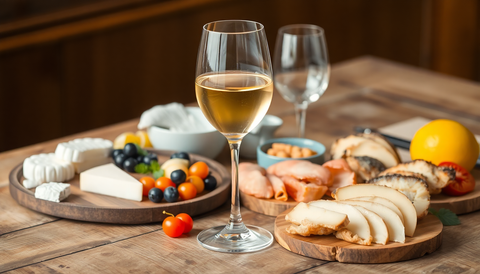Riesling, the noble grape of Germany, has long been revered for its captivating aromas, vibrant acidity, and remarkable versatility. As one of the world's most celebrated white wine varieties, Riesling has the power to enchant the senses and transport wine enthusiasts on a journey of discovery. However, to truly appreciate the nuances and complexities of this remarkable wine, it is essential to understand the art of serving and storing it properly.
In this comprehensive guide, we will delve into the intricacies of Riesling, exploring the optimal serving temperature, the importance of glassware, and the secrets of cellaring this exceptional wine. Whether you are a seasoned Riesling connoisseur or a newcomer to the world of this captivating grape, this blog post will equip you with the knowledge to unlock the full potential of every Riesling you encounter.
The Importance of Serving Temperature
The serving temperature of Riesling is a crucial factor in unlocking its aromatic profile and balancing its natural acidity. Riesling's delicate flavors and refreshing character can be easily overwhelmed or muted by serving it at the wrong temperature.
The Ideal Serving Temperature
The optimal serving temperature for Riesling typically falls between 45°F (7°C) and 50°F (10°C). This range allows the wine to showcase its vibrant fruit flavors, floral aromas, and crisp acidity, while still maintaining a refreshing and balanced mouthfeel.
Adjusting the Temperature
If your Riesling is served too cold, it can mute the wine's aromas and flavors, making it seem flat and one-dimensional. Conversely, if the wine is served too warm, the acidity can become overpowering, and the delicate nuances may be lost.
To achieve the perfect serving temperature, you can use a few simple techniques:
- Refrigerate the wine for 30-60 minutes before serving, depending on the starting temperature.
- Use an ice bucket or wine cooler to maintain the ideal temperature during the meal.
- If the wine is too cold, let it sit at room temperature for a few minutes to gently warm up.
By paying close attention to the serving temperature, you can ensure that your Riesling is presented at its best, allowing the wine's true character to shine.
The Importance of Glassware
The choice of glassware can have a significant impact on the way Riesling is perceived and enjoyed. The shape and size of the glass can influence the wine's aroma, flavor, and overall drinking experience.
Riesling-Specific Glassware
Riesling is best served in a glass that is designed specifically for the varietal. These glasses typically have a tall, narrow bowl with a slightly tapered rim. This shape helps to concentrate the wine's aromas, directing them towards the nose and enhancing the overall sensory experience.
The Benefits of Riesling Glassware
The tall, narrow bowl of a Riesling glass allows the wine to maintain its cooler serving temperature for longer, preserving the delicate aromas and flavors. Additionally, the tapered rim helps to direct the wine's flow, ensuring a smooth and balanced sip.
Alternative Glassware Options
While Riesling-specific glassware is the ideal choice, you can also enjoy Riesling in a standard white wine glass or a universal wine glass. These alternatives may not provide the same level of aroma concentration and temperature control, but they can still be used to appreciate the wine's qualities.
Regardless of the glassware you choose, it is essential to ensure that the glass is clean, free of any residual odors, and properly rinsed to avoid interfering with the wine's aromas and flavors.
The Art of Cellaring Riesling
Riesling is a wine that can age gracefully, often developing complex and nuanced flavors over time. Proper cellaring techniques are crucial for preserving the wine's quality and allowing it to reach its full potential.
Optimal Cellaring Conditions
The ideal cellaring conditions for Riesling include a cool, dark, and humid environment. The recommended temperature range is between 55°F (13°C) and 65°F (18°C), with a humidity level of 60-70%. Exposure to direct sunlight or significant temperature fluctuations can negatively impact the wine's development.
Cellaring Timeframes
Riesling's aging potential can vary depending on the style and vintage. Generally, dry and off-dry Rieslings can age for 5-10 years, while sweeter styles can develop for 10-20 years or more. The best way to determine a Riesling's optimal drinking window is to consult the producer's recommendations or seek guidance from experienced wine professionals.
Cellaring Techniques
To ensure the proper cellaring of Riesling, consider the following techniques:
- Store the bottles on their side to keep the corks moist and prevent air from entering the bottle.
- Avoid stacking bottles directly on top of each other, as this can cause damage to the labels and make the bottles difficult to access.
- Monitor the temperature and humidity levels in your cellar or storage area, making adjustments as needed to maintain the ideal conditions.
- Consider investing in a dedicated wine refrigerator or temperature-controlled wine storage unit to ensure precise temperature and humidity control.
By following these cellaring best practices, you can unlock the true potential of your Riesling collection, allowing the wine to evolve and develop its complex flavors over time.
Conclusion
Riesling is a wine that demands attention and respect. By understanding the importance of serving temperature, glassware, and cellaring techniques, you can unlock the full potential of this remarkable grape and enjoy Riesling at its best. Whether you are savoring a crisp, refreshing Riesling on a warm summer day or exploring the depth and complexity of an aged Riesling, the insights provided in this blog post will guide you on your journey of Riesling discovery.
So, the next time you uncork a bottle of Riesling, take a moment to appreciate the care and attention that goes into serving and storing this exceptional wine. With a little knowledge and a lot of passion, you can elevate your Riesling experience and truly appreciate the magic of this versatile and captivating varietal.




Comments (0)
There are no comments for this article. Be the first one to leave a message!